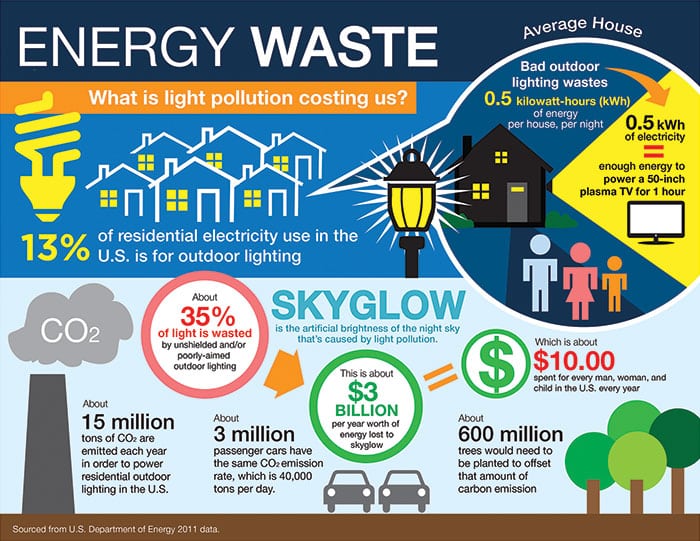Light Pollution
In the previous section, we have identified the ABCs of outdoor lighting and cautioned that the careless utilization of artificial lighting results in light pollution. In this section, the GLDS wants to outline the three steps essential to reduce light pollution and create a Dark Sky environment. They are as follows:
- Human-Made Light Pollution Components
- The Byproducts of Light Pollution
- Light Pollution Solutions
Human-Made Light Pollution Components
- Glare – Strong, luminous light that results in excessive brightness that causes visual discomfort.
- Clutter – Groupings of light sources that emit excessive glare. Clutter contributes to light trespass.
- Light Trespass – Light, individual or a cluster, that crosses over from one property or parcel of land onto another in a built-up/populated area.
- Sky Glow – The proliferation of clutter and light trespass in a built-up/populated area that produces a luminous background that inhibits one’s ability to view the stars. Sky glow is highly variable on the amount of light being emitted upwards, immediate weather conditions and the quantity of air particles (dust and gas) in the immediate geographic area.
80% of the world’s population lives under light polluted skies.
Source: World Atlas of Artificial Night Sky Brightness
The Byproducts of Light Pollution
For hundreds of millennia, mankind experienced a natural night sky bursting with stars. It was an integral part of the day and night cycle of life. The natural dark sky enabled man to better understand its place in the universe. Consequently, it inspired science, religion, philosophy, literature and art. Artificial light that resulted in light pollution disruptive this natural cycle and had a negative impact in our world as follows: Wildlife and Ecosystems An ecosystem is a biological community of interacting organisms and their physical environment. Plants and animals are reliant on our planet’s daily cycle of light and dark to maintain its sustainable rhythm. The addition of light pollution at night disrupts the habitat. Some primary examples:
Energy Waste
The International Dark Sky Association estimates that 30 percent of all outdoor lighting (lighting that is not shielded) in the U.S. alone is wasted. This wasted energy has huge economic and environmental consequences – approximately $3.0 billion in energy costs per year and the release of an estimated 15 million tons of carbon dioxide (source: U.S. Department of Energy 2011).

Health & Well Being
Humans sleep-wake pattern (a.k.a. biological clock) are controlled by the day-night cycle they are exposed to. Artificial light can disrupt that cycle. In medical terms, that cycle is known as a circadian rhythm. Our bodies produce a hormone (melatonin) which keeps us healthy – positive functioning of key organs, lower cholesterol, stronger immune system, etc. Exposure to artificial light at night, especially blue light according to a 2015 Harvard Medical Study can be disruptive and suppresses our melatonin production.
Brighter does not mean safer when it comes to outdoor lighting deterring crime or reducing accidents. Numerous published studies have found that increased streetlights do not prevent crime. In reality, too much outdoor lighting utilized to enhance safety and security at night increases overall energy costs and produces glare which actually impairs visibility since the pupils in our eyes constrict as a result.